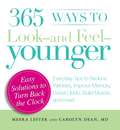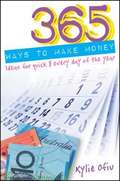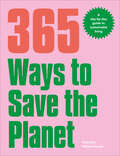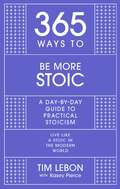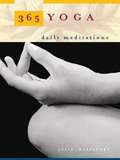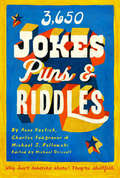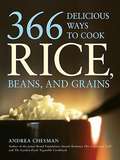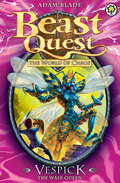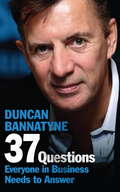- Table View
- List View
365 Ways to Live the Law of Attraction
by Meera LesterLove, success, happiness, a long and healthy life-these are the things the Law of Attraction promises to deliver-but how? It sounds easy enough, but what does it really mean? In this book, you find the practical steps you need to harness the power of the universe and transform your life. Each of the 365 entries provides a simple, concrete action item guaranteed to attract good things into the your life, such as: Use the tarot to attract the perfect romantic partner Learn to say no to the bad so you can say yes to the good Make a wealth poster to attract more success Run a water fountain to stimulate the positive flow of money Use affirmations to boost your healthy energy Meditate to achieve serenity and peace of mind With this engaging, enlightening guide, you find the spiritual path to your wildest dreams, one day at a time!
365 Ways to Live the Law of Attraction
by Meera LesterLove, success, happiness, a long and healthy life-these are the things the Law of Attraction promises to deliver-but how? It sounds easy enough, but what does it really mean? In this book, you find the practical steps you need to harness the power of the universe and transform your life. Each of the 365 entries provides a simple, concrete action item guaranteed to attract good things into the your life, such as:Use the tarot to attract the perfect romantic partnerLearn to say no to the bad so you can say yes to the goodMake a wealth poster to attract more successRun a water fountain to stimulate the positive flow of moneyUse affirmations to boost your healthy energyMeditate to achieve serenity and peace of mind With this engaging, enlightening guide, you find the spiritual path to your wildest dreams, one day at a time!
365 Ways to Look - and Feel - Younger
by Meera Lester Carolyn DeanOkay, so you are 35 . . . 40 . . . 50 . . . 60 . . . and counting. You've got a few laugh lines here, a little cellulite there. And sometimes you can't remember your own name. But you're not ready for the old folks' home yet.With this book, you can look better, feel better, and live better--every day of the year. Inside this comprehensive, practical guide, you'll find easy things you can do every day to make the rest of your life the best of your life, such as:Fight wrinkles with eel grapesTry the Yab Yum sexual position with your partner tonight Fight cellulite with circuit trainingAdopt a dog--and walk it every dayLearn French--and then book a trip to ParisFrom superfoods and weight training to memory boosters and real-life aphrodisiacs, these are anti-aging tips and tricks that really work--no matter what your age. Because you're not getting older, you're getting stronger, smarter, sexier, thinner, wiser, bolder, happier . . .
365 Ways to Look - and Feel - Younger
by Meera Lester Carolyn DeanOkay, so you are 35 . . . 40 . . . 50 . . . 60 . . . and counting. You’ve got a few laugh lines here, a little cellulite there. And sometimes you can’t remember your own name. But you’re not ready for the old folks’ home yet.With this book, you can look better, feel better, and live better—every day of the year. Inside this comprehensive, practical guide, you’ll find easy things you can do every day to make the rest of your life the best of your life, such as:Fight wrinkles with eel grapesTry the Yab Yum sexual position with your partner tonight Fight cellulite with circuit trainingAdopt a dog—and walk it every dayLearn French—and then book a trip to ParisFrom superfoods and weight training to memory boosters and real-life aphrodisiacs, these are anti-aging tips and tricks that really work—no matter what your age. Because you’re not getting older, you’re getting stronger, smarter, sexier, thinner, wiser, bolder, happier . . .
365 Ways to Make Money
by Kylie OfiuThe how-to guide to making real money with little or no start-up costsWe'd all like to find out how to make money. 365 Ways to Make Money proves that you don't have to be a slick entrepreneur or become embroiled in get-rich-quick schemes to boost your cash flow. In fact, this guide shows that anyone can make money--up to thousands of dollars--with little or no start-up costs. This guide shows there are ways to make money, whether you are a stay-at-home parent, a student or a professional looking for extra income, or a hobbyist looking to convert your interest into cash.365 Ways to Make Money is the ultimate inspirational, yet practical, guide to finding ways to earn extra income. With one tried-and-true idea for every day of the year, it looks at ways you can instantly put your ideas in to practice, providing money-making ideas from every area of your life--from your home and cars to your knowledge and interests.More than just a list of ideas, this is a real how-to guide, with tried and tested strategies.Unlike other moneymaking titles, this book also gives you the financial knowledge you need to support your moneymaking journey.
365 Ways to Raise Your Frequency: Simple Tools to Increase Your Spiritual Energy for Balance, Purpose, and Joy
by Melissa AlvarezConnect with your core spiritual self and increase your vibrational rate with 365 easy ideas quick enough to enjoy every day. When you use this guide to raise your frequency, you empower yourself to turn positive energy into happiness and abundance.Elevated spiritual energy attracts purpose and joy into your life. Use these inspiring daily entries to create positive intention as you discover:How to identify your present frequency and build a foundation for growthSimple exercises for letting go of the negative energy that lowers your frequencyTechniques for interpreting messages from your spirit guidesCreative ways to use crystals, stones, and colors to attract positive energy
365 Ways to Reduce Stress
by Eve AdamsonIt's a crazy world--but you don't have to let it get to you. No matter what kind of stress you're under--good, bad, or simply constant--you can remain calm, centered, and content. With this book, you'll find hundreds of ways to reduce your stress level, starting now. With quizzes designed to identify your key stress triggers, you'll learn how to avoid, reduce, and/or eliminate anxiety in your daily life. You'll also master the art of creating and maintaining a sane and serene outlook, no matter what may come your way. With the clever and creative de-stressing strategies in this hands-on guide, you'll reshape your work and home life--so you can get the rest and relaxation you need to enjoy each and every day to the fullest. If you're feeling overworked, overscheduled, and overstressed, this stress-cure-in-a-book will help you breathe a little easier--and live a lot happier!
365 Ways to Reduce Stress
by Eve Adamson• The only tip-based book to offer strategies for managing stress every day of the year • 48 percent of Americans say they’re more stressed now than they were five years ago (New York Post) • The current economical climate is stressful—“Being fired or laid off can lead to clinical depression, violence, and alcohol abuse, as well as strokes and heart attacks.” (Newsweek) There’s always more to do and not enough time to do it in! Today, more than ever, people need relief from the pressures of everyday life. Stress can lead to damaging physical and mental health issues, so it’s important to take control and manage stress effectively. From cutting caffeine intake to doodling in a journal, readers find the daily comfort they long for in 365 Ways to Reduce Stress. This hands-on, tip-based guide offers simple advice for how to remain calm and centered, no matter what the day brings— including how to: • Calculate your stress vulnerability factor • Identify and eliminate environmental stressors • Nourish your emotional, physical, and spiritual selves • Avoid stress triggers and relax pro-actively This inspiring tool for the overworked, over-scheduled, and overstressed will allow readers to breath a little easier and live a lot happier—each and every day!
365 Ways to Save the Planet: A Day-by-day Guide to Living Sustainably (365 Series)
by Nergiz De BaereARE YOU READY TO CHANGE THE WORLD?365 WAYS TO SAVE THE PLANET is a full year's worth of daily wisdom, carefully selected to inspire you to take the urgent action our very existence desperately needs. You'll find actions and challenges, surprising facts about the climate crisis, templates for writing to political representatives, scientific explanations of important concepts, popular misconceptions about sustainability, and much more. 365 WAYS TO SAVE THE PLANET goes way beyond predictable sustainability advice about how to recycle. Here you'll discover the small stuff you can do every day to change the world. Because when you get the little things right, the big things follow.
365 Ways to Save the Planet: A Day-by-day Guide to Living Sustainably (365 Series)
by Nergiz De BaereARE YOU READY TO CHANGE THE WORLD?365 WAYS TO SAVE THE PLANET is a full year's worth of daily wisdom, carefully selected to inspire you to take the urgent action our very existence desperately needs. You'll find actions and challenges, surprising facts about the climate crisis, templates for writing to political representatives, scientific explanations of important concepts, popular misconceptions about sustainability, and much more. 365 WAYS TO SAVE THE PLANET goes way beyond predictable sustainability advice about how to recycle. Here you'll discover the small stuff you can do every day to change the world. Because when you get the little things right, the big things follow.
365 Ways to Save the Planet: A Day-by-day Guide to Sustainable Living
by Georgina Wilson-PowellStep up your sustainability and unlock your full eco potential with 365 easy, trackable changes. What if sustainability didn&’t have to be so complicated? 365 Ways to Save the Planet cuts through the noise and explains exactly how to live a &“greener&” lifestyle day by day. With its approachable ideas and achievable daily actions, anyone can up their sustainability score with this book on eco-friendly living. Georgina Wilson-Powell breaks down the significance of environmental statistics for issues big and small, and quantifies the difference low-effort, high-impact changes can make. In her year-long programme, each action is accompanied with a simple &“Impact Index&” to bring the statistics to life, making it easy to track your progress. Reflect positively on the impact you are having on the environment, across work, home, holiday, and more, for the duration of a full year. Dive into the pages of this superb sustainability book to discover: - Daily actions and reflections focus on different, key sustainability issues to build into your routine.- Pages include inspiring mottos, overarching statistics, and illustrations to create a bold, colourful course for the year.- An impact index accompanies each daily action helping you to measure your footprint and reflect on the difference you can make. This green-living guide presents the facts and suggests changes to readers&’ lifestyle for every day. If you want to make a difference but don&’t know where to begin, simply turn the page and start with day one, and learn how to break previous habits and shift your mindset. Being green has never been easier!
365 Ways to be More Stoic: A day-by-day guide to practical stoicism
by Tim LebonHAPPINESS, SERENITY AND FULFIMENT ARE ALL WITHIN YOUR CONTROL365 WAYS TO BE MORE STOIC is a full year's worth of daily inspiration, tools, stories, actions, and rituals that will guide you to a meaningful life, filled with happiness. It is a simple, list-driven, practical guide that will allow you to immediately begin putting Stoic wisdom into practice in your daily life. Each short chapter makes Stoicism fun to read about and easily digestible, presenting ideas in engaging, bite-size chunks.Immerse yourself in stoicism right from the first chapter, through prompts, concepts, challenges, inspiration, quotes, examples, quizzes and case-studies. You'll learn to navigate through the controllable and inevitable. You'll develop constructive ways to handle frustration, adversity and even your own mortality. You'll learn habit-forming strategies, pick up helpful concepts, and uncover tips for lasting change. This fun and engaging manual will help you live like a Stoic in the modern world. 365 WAYS TO BE MORE STOIC focuses on the small stuff you can do every day to live a happier and wiser life. Because when you get the little things right, the big things follow.
365 Ways to be More Stoic: A day-by-day guide to practical stoicism
by Tim LebonHAPPINESS, SERENITY AND FULFIMENT ARE ALL WITHIN YOUR CONTROL365 WAYS TO BE MORE STOIC is a full year's worth of daily inspiration, tools, stories, actions, and rituals that will guide you to a meaningful life, filled with happiness. It is a simple, list-driven, practical guide that will allow you to immediately begin putting Stoic wisdom into practice in your daily life. Each short chapter makes Stoicism fun to read about and easily digestible, presenting ideas in engaging, bite-size chunks.Immerse yourself in stoicism right from the first chapter, through prompts, concepts, challenges, inspiration, quotes, examples, quizzes and case-studies. You'll learn to navigate through the controllable and inevitable. You'll develop constructive ways to handle frustration, adversity and even your own mortality. You'll learn habit-forming strategies, pick up helpful concepts, and uncover tips for lasting change. This fun and engaging manual will help you live like a Stoic in the modern world. 365 WAYS TO BE MORE STOIC focuses on the small stuff you can do every day to live a happier and wiser life. Because when you get the little things right, the big things follow.
365 Yoga
by Julie RappaportAn elegant and enlightening companion book for yoga practitioners. This beautifully designed book invites readers to dis-cover the rich tradition of yoga through single pieces of wisdom-one for each day of the year. Filled with thought-provoking and inspiring quotations from the greatest yogic texts and yoga teachers throughout history, as well as invaluable instruction on specific poses, it is an essential resource and companion for anyone who practices yoga. A celebration of the powerful ancient practice that is yoga, this book guides readers-day by day-through centuries of yogic philosophy. 365 Yoga infuses yoga practice with a deeper understanding of the intricate connection of mind, body, and spirit. .
3650 Jokes, Puns, and Riddles
by Michael J. Pellowski Anne Kostick Charles FoxgroverThis classic collection of jokes, puns, and riddles features the outrageous and the inane, the silly and the side-splitting, and will have you, your family, and friends laughing, moaning, guffawing, and rolling in uncontrollable bursts of laughter. It's for everyone who, from time to time, needs a little laughter in their lives. And who doesn't? Between these covers are a staggering 3650 entries -- at a joke a day that's 10 full years of comedy! With chapters on everything from Modern Romance, the Working World and Aging to Pop Culture, Money, and much more, 3650 Jokes, Puns and Riddles contains the most ridiculous quip for every conceivable occasion. There are gibes, barbs, and insults, knock-knock jokes, and one-liners, doctor jokes and lawyer jokes, animal jokes and family jokes, and throughout a seemingly endless supply of bad puns. 3650 Jokes, Puns and Riddles will have you chuckling, chortling, giggling, grinning, and groaning in spite of yourself.
366 Days in Abraham Lincoln's Presidency: The Private, Political, and Military Decisions of America's Greatest President
by Harry Turtledove Stephen A. WynaldaIn a startlingly innovative format, journalist Stephen A. Wynalda has constructed a painstakingly detailed day-by-day breakdown of president Abraham Lincoln's decisions in office-including his signing of the Homestead Act on May 20, 1862; his signing of the legislation enacting the first federal income tax on August 5, 1861; and more personal incidents like the day his eleven-year-old son, Willie, died. Revealed are Lincoln's private frustrations on September 28, 1862, as he wrote to vice president Hannibal Hamlin, "The North responds to the [Emancipation] proclamation sufficiently with breath; but breath alone kills no rebels." 366 Days in Abraham Lincoln's Presidency includes fascinating facts like how Lincoln hated to hunt but loved to fire guns near the unfinished Washington monument, how he was the only president to own a patent, and how he recited Scottish poetry to relieve stress. As Scottish historian Hugh Blair said, "It is from private life, from familiar, domestic, and seemingly trivial occurrences, that we most often receive light into the real character." Covering 366 nonconsecutive days (including a leap day) of Lincoln's presidency, this is a rich, exciting new perspective of our most famous president. This is a must-have edition for any historian, military history or civil war buff, or reader of biographies.
366 Delicious Ways to Cook Rice, Beans, and Grains
by Andrea ChesmanAndrea Chesman presents 366 creative and flavorful "natural gourmet" recipes using a wide variety of beans and grains, like basmati and jasmine rice, adzuki beans, amaranth, and quinoa. Organized by course and main ingredient, these dishes range from light and lively starters to hearty and soul-satisfying foods that stick to your ribs but not to your waistline. American favorites are well represented here, but adventurous cooks will be pleased to find ethnic cuisines dominating this mouthwatering collection, including such recipes as: Healthy Mediterranean diet-inspired recipes Spicy Vegetable Couscous Pesto Pasta with Cranberry Beans Smoky Black Bean Burritos Jamaican-Style Rice and Peas This wonderful addition to our 366 Ways series features foods that are among the most versatile and healthful in the human diet, not to mention absolutely delicious. Recipes are high in flavor, low in fat. Each recipe includes a detailed nutritional analysis, which counts calories, fat, percentage of calories from fat, protein, fiber, sodium, and calcium. Vegetarian dishes dominate the collection, but healthful variations include salmon, shrimp, and chicken.
36: Vespick the Wasp Queen
by Adam BladeTom has nearly reached the end of his most challenging Beast Quest! The fate of his mother and the land of Kayonia depend on him and his faithful companions. Can he defeat the deadliest of his foes, Vespick the Wasp Queen, and wicked Wizard Velmal?
37
by Maria BeaumontOn the eve of her thirty-seventh birthday, Fran Clark finds herself in a role she would never have envisioned: that of a surprisingly desperate housewife. As Fran halfheartedly attempts to relaunch her once-vibrant career as a voiceover artist and obsesses over keeping up with the ruthless mothers' scene at her children's school, she begins to realize that her thirty-seventh year isn't going to resemble the midlife bliss she had imagined. Instead, she makes excuses for the fact that she's depressed and drinking -- a lot. But when Fran realizes she has failed her children one too many times, and begins to suspect her husband is having an affair, she knows she has hit rock bottom. It is Fran's two closest friends who ultimately come to her rescue. She learns to thank them for her salvation -- not because they are there for her, but because she discovers how to be there for them. Literate and well written, 37 is a searingly intimate and compulsively readable novel, a very modern diary of a (not quite) mad housewife. Filled with acute, often bitingly funny observations about motherhood, friendship, and the claustrophobia of suburbia, this pitch-perfect novel will resonate with any woman who has ever been stricken with self-doubt. 37 is Maria Beaumont's third novel. After the mums from her kids' school have finished with her, it may be her last.
37 Cents a Fart and other Infamous Animal Stories
by Henry HarveyTrue, entertaining stories about real animals accompanied by 60 charming illustrations40+ vignettes about charismatic, humorous, and genius members of the animal kingdomA page turner with funny (sometimes adult funny) twists
37 Days at Sea: Aboard the M.S. St. Louis, 1939
by Barbara KrasnerIn May 1939, nearly one thousand German-Jewish passengers boarded the M.S. St. Louis luxury liner bound for Cuba. They hoped to escape the dangers of Nazi Germany and find safety in Cuba. In this novel in verse, twelve-year-old Ruthie Arons is one of the refugees, traveling with her parents. Ruthie misses her grandmother, who had to stay behind in Breslau, and worries when her father keeps asking for his stomach pills. But when the ship is not allowed to dock in Havana as planned—and when she and her friend Wolfie discover a Nazi on board—Ruthie must take action. In the face of hopelessness, she and her fellow passengers refuse to give up on the chance for a new life.
37 Houseplants Even You Can't Kill
by Mary Kate HoganHave the leaves dropped off your houseplants long ago? Here's the good news: you're not missing some mysterious green thumb gene. These 37 varieties of foliage, flowers and cacti will thrive even when almost totally ignored. Best of all, there's no need to sacrifice lushness, beauty or even delicacy. You'll find all the easy-to-follow basics you will ever need to show off your gardening prowess, even if you don't have any!
37 Questions Everyone in Business Needs to Answer
by Duncan BannatyneThe UK's number 1 business expert is back with another dose of razor-sharp advice and insight. With Duncan's help you will be able to cut to the chase of the most important business issues, and have brilliant answers ready at your fingertips.
37 Questions Everyone in Business Needs to Answer
by Duncan BannatyneBestselling business author and star of BBC TV's Dragons' Den, Duncan Bannatyne is back with a brand new book. 37 Questions covers all the essential queries business managers and entrepreneurs should be able to ask themselves and answer honestly, but so often fail to do so, such as: What's my most profitable line?What do my customers want next?Who's my greatest business rival?What might stand in my way?
37 Seconds: Dying Revealed Heaven's Help
by Stephanie Arnold Sari Padorr“Riveting . . . inspiring. . . . the story of what happened to this woman when she died for 37 seconds will make you rethink how we all should live.” —Maureen Maher, CBS News correspondent, 48 HoursWhen she was pregnant with her second child, Stephanie Arnold had a sudden and overwhelming premonition that she would die during the delivery. Though she tried to tell the medical team and her family what was going to happen, neither the doctors nor her loved ones gave her warnings credence. Finding no physical indications that anything was wrong, they attributed her foreboding to hormones and anxiety.One member of the medical team did take her concerns seriously enough, and made the fateful decision to order extra units of blood “just in case.” Then, during the delivery, Stephanie suffered a rare Amniotic Fluid Embolism. She went into cardiac arrest and flat-lined for 37 seconds. She died. Using the supplementary blood, the medical team revived her, and she remained unconscious for more than six days.After months of recovery, Stephanie began to remember details of her experience, details she knew because she had witnessed the entire dramatic event, including her death, from outside her body—beside other spirits that were with her. In this remarkable true story, Stephanie recounts her harrowing journey and shares her surprising spiritual discoveries: we are not alone and have more loving help than we can imagine surrounding us.“Stephanie Arnold’s journalistic instincts made this remarkable happening a compelling reading experience.” —Dennis Swanson, President of Station Operations at Fox Television“Arnold’s amazing, enthralling, and revealing story . . . could redefine the way clergy, physicians, and scientists think about dying.” —Dr. Rachael Ross, co-host of The Doctors

